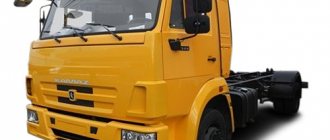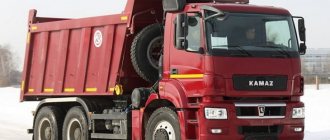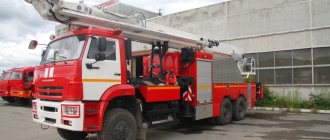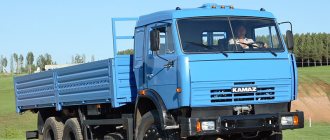For any truck, engine displacement is the most important technical parameter, which affects the following features:
- Performance: An engine with a larger displacement and cylinder capacity is able to generate more mechanical energy.
- Power and torque: for trucks, the second parameter is the most important, it is directly proportional to engine size.
- Fuel consumption: for KamAZ engines it is quite high, but is compensated by the above advantages.
How well KamAZ will perform the tasks assigned to it depends partly on how many liters are in the engine. The manufacturer is constantly working on this and improving its technology.
Powertrains 740
At the moment, the manufacturer is focused on unifying engines for all KamAZ trucks and increasing the level of environmental safety of the units.
The 740 engines are represented by V-shaped eight-cylinder models. By volume, KamAZ engines can be divided into two groups:
10.85 l
KamAZ engines with a volume of 10.85 liters are classified according to Euro standards:
- Euro-0: these are diesel engines 740.10 and 7403 with a power of 210 and 240 hp, installed on KamAZ models 5410, 54112, 5320, 55102, 5511.
- Euro-1: engines 740.11 and 740.13 with 240 and 260 hp. meet environmental standards and are suitable for almost all KamAZ models.
- Euro-2: this line of engines is represented by models 740.30 and 740.31 with a power of 260 hp. – universal for almost all KamAZ trucks.
11.76 l
This group includes high-power KamAZ engines of at least Euro-2 standard:
- Euro-2: engines for all KamAZ trucks are represented by models 740.50 and 740.51 - 360 hp. and 320 hp respectively.
- Euro-3: engines 740.60 (360 hp), 740, 61 (320 hp), 740.62 (280 hp), 740.63 and 740.37 (400 hp each).
- Euro-4: represented by the most powerful and modern units 740.70 (280 hp), 740, 71 (320 hp), 740.72 (360 hp), 740.73 (400 hp), 740.74 ( 420 hp), 740.75 (440 hp).
Repairs and malfunctions
Like any power unit, the 740 engine tends to break down.
Our repair specialists will be able to help you with KamAZ engine repairs and order repairs
Most malfunctions are the result of violation of recommendations and maintenance schedules. Before operating the vehicle, we strongly recommend that you study the reference manual for the operation and maintenance of Kamaz engines.
Malfunctions of the 740 engine can be caused by problems in the connecting rod and crank mechanisms and in the mechanics that are responsible for gas distribution. Usual signs: the appearance of dull and rhythmic knocks at the bottom of the engine crankcase, as well as the presence of loud knocks inside the cylinder.
In connecting rod and crank mechanics, problems can be caused by poor damping of the journals inside the crankshaft, as well as wear of the bearings. It is possible for the liners to rotate, as well as jamming inside the crankshaft due to coked oil channels inside each journal, breakage of connecting rods or connecting rod bolts, wear of piston rings, as well as cylinder liners, wear of the holes necessary for the passage of cooling fluid inside the cylinders under the influence of shock vibration .
Knock in the middle of the engine block.
Motor power indicators decrease, fuel and oil consumption increases, and smoke increases due to exhaust gases. Inside the piston grooves, piston rings and cylinder liners burn and wear out. The engine does not start, starts and stalls.
Loss of engine power. The main reason is the presence of water in the fuel. Drain water and sediment from the coarse filter daily. Turn off the engine. Open the drain valve. Turn the valve handle counterclockwise 4 full turns so that the valve drops 2.5 cm. If the amount of fluid drained exceeds 50-60 grams, add fuel to the filter.
Another reason for difficulty starting the engine is air sucking into the fuel lines. It is necessary to check all fuel line connections for leaks.
Contamination of fuel filters (FGOT, FTOT) and fuel intake. Air filter dirty. Rinse the tank, replace the fuel and air filters.
Contact a car service center for engine diagnostics.
Oil leakage
Never operate the engine if the oil level is above or below the marks.
Check the oil level after turning off the engine no earlier than 5 minutes after stopping. Increased engine temperature.
Do not overheat the engine above 100°C.
Do not add cold coolant to a hot engine, as this may cause engine failure.
Strong vibration and engine noise.
Knock of valves in the engine timing belt. Violation of adjustments of the gas distribution mechanism and engine fuel injection pump. Adjust thermal clearances and fuel injection advance angle. Carry out routine maintenance. Contact a car service for diagnostics.
An increase in the smokiness of exhaust gases with a specific bluish tint when they exit the muffler and a drop in oil pressure are a consequence of a malfunction of the lubrication system.
Cummins engines
Cummins engines for KamAZ trucks are represented by six- and eight-cylinder units. For engines of all sizes there is a version that meets environmental standards, as a rule, these are Euro-3, -4 and -5.
The following Cummins engines are in demand for KamAZ trucks:
- 6.7 l – engine capacity sufficient for medium-power KamAZ trucks: 6ISBe210, ISB6.7, ISB6.7e4, ISB6.7E5, ISB6.7E6.
- 8.9 l - this working volume is intended for KamAZ trucks of medium and high power, with a load capacity of up to 20 tons: L360 20*, ISLe400 40, ISL400 50.
- 11.8 l: ISG12E5, ISG12 - these engine models are suitable for truck tractors and dump trucks with a carrying capacity of over 25 tons.
- 14.9 l: ISXe535, QSX15 - suitable for heavy trucks and tractors that are used as part of a road train.
KamAZ 740 and Cummins engines are offered by the KamRemCenter company - new and used engines are available under warranty.
You can also order engine repair services from us. WE HAVE WHAT YOU NEED! +7
KamAZ-53501: all-wheel drive truck of the Mustang family
Production of the KamAZ-53501 multi-purpose vehicle began in 2003 and continues to this day. The main purpose of the truck is to transport personnel and army cargo. Taking into account the requirements for military equipment, the model received a particularly durable frame and all-wheel drive on six wheels (wheel formula 6 * 6). The car is designed to operate in different climatic zones; according to eyewitnesses, the engine starts easily in temperature conditions from – 45 to + 45.
KamAZ-53501
The KamAZ-53501 power plant is located on the front part of the frame, above it there is an all-metal, folding, cabover cab designed for a driver and two passengers with a sleeping place for rest. Most military trucks are equipped with an armored cab, with bulletproof glass and a floor reinforced with special sheets. The interior of the truck is ascetic, but it has everything you need to drive the vehicle and monitor its technical condition. Let us note a fairly ergonomic and informative panel.
KamAZ-53501 with a residential module
Quite often, various additional superstructures are installed on the KamAZ-53501 platform: an armored module for transporting personnel, an excavator unit, a tank, and various manipulators. The vehicle can also transport large cargo, including containers.
The new KamAZ-53501 in its simplest configuration will cost the buyer 3,450,000 rubles. Cars removed from military preservation with mileage from 5 to 20 thousand kilometers are in great demand. The price for such cars starts at 2.3 million rubles.
P5ZV7385_new size
In terms of dimensions, the D946 engine is comparable to European diesel engines with a volume of 12–13 liters, but here a lot depends on the size and center-to-center distance.
In terms of dimensions, the D946 engine is comparable to European diesel engines with a volume of 12–13 liters, but here a lot depends on the size and center-to-center distance.
It would be possible to buy a license and technological assembly lines, as GAZ Group did with the Renault Trucks DCi 11 engine for the Yaroslavl Motor Plant. But there the engine was initially of Euro-3 level, although with the possibility of fine-tuning to Euro-4.
But in Chelny they are preparing for production their own Euro-5 engines - the traditional V-shaped “eight” KAMAZ-740.735-400 and KAMAZ-750.10-400. Why spend extra money and time developing an in-line six-cylinder engine just for the sake of having one?
The fact is that long-time supporters of V-shaped diesel engines for trucks Mercedes-Benz and Scania also plan to curtail their production in favor of in-line “sixes” for a reason. This is primarily due to the design features of engines of Euro 6 and higher levels. To neutralize exhaust gases, to optimize the settings of electronically controlled diesel fuel systems, a combination of exhaust gas recirculation (EGR), urea water injection (SCR) and a regenerable particulate filter will not be enough. Experts agree that these systems will have to be supplemented with a turbo compound. That is, by installing another turbine, which additionally tightens the crankshaft through a viscous coupling and a reduction gearbox, without wasting fuel. Free power allows you to throttle the engine for the sake of the environment without any problems.
Six in a row: details about the new Kamaz R6 engine
V8 and R6: who wins?
Let's start with a little information and tell you what engines are currently installed on Chelny trucks and why.
In Kamaz trucks you can find three units: the “native” diesel engine of the 740 series, as well as Daimler OM 457 and Cummins engines. The 740 engines are the only ones in the line with eight cylinders.
Imported engines are in-line sixes, like the future new P6. Such engines are now the most popular in the world of trucks. But once upon a time the 740 engine was quite an advanced unit! Let's remember his story.
In 1967, the Moscow Likhachev plant began developing a family of ZIL-170 trucks with a 6x4 wheel arrangement. In 1969, the first sample was ready, and its production was transferred to a new plant in Naberezhnye Chelny, which at that time was still under construction.
Articles / Trucks and buses The new KAMAZ R6 engine has entered the pre-production stage The Kolesa.ru portal visited the KAMAZ plant in Naberezhnye Chelny, where it found out new details about the progress of the project to create a domestic engine for trucks. 8096 0 27 05/18/2016
In 1976, the Kamaz-5320 rolled off the assembly line of the new enterprise, which in essence was the 170th ZiL. The power unit then was the Yaroslavl YaMZ with a volume of 11.5 liters, which produced from 180 to 210 liters. With. The production of these diesel engines was established at Kamaz back in 1975, and this is where the 740 series unit originates. What was good about this engine?
Firstly, the Kamaz diesel engine is the first of the Soviet engines to receive a closed cooling system, which was supposed to use antifreeze rather than water. The drive of the radiator cooling impeller received a fluid coupling, and the entire system received a thermostat. There were other technological innovations in this engine (full-flow oil filtration system with a centrifuge, nitrided crankshaft, removable cermet guides for valves, etc.), but forty years have passed since then.
Of course, over these decades the engine has been modified several times, but nothing can be altered endlessly: someday you will still have to invent something fundamentally new. Moreover, boosting an old engine has become simply expensive and therefore even more pointless. Add here the strict Euro-5 standards, a “Procrustean bed” that is too tight for the old V8. In a word, the need to create a new engine appeared a long time ago.
There are a lot of good straight sixes in the world. You can, of course, come up with another engine - Kamaz knows how and loves to invent something like that - but it would be unreasonably time-consuming and expensive. In modern automobile production, somewhat different trends have long been established, so they decided to look for a base for the new engine among other manufacturers with whom the company has established long-standing partnerships.
Why P6 and what does Liebherr have to do with it?
I have already said that the new Kamaz engine must necessarily comply with Euro-5, and in the future – Euro-6. It is difficult for a V8 engine to meet these standards in principle: a device with the complex and scary name of turbocompound “gets along” with it very poorly. What kind of animal is this?
In an average diesel engine, about 30-40% of thermal energy flies out with exhaust gases, which you really want to somehow make work. For the first time, this trick was partially successful at Scania, which in 1961 installed a turbocharger on one of its engines. The device is familiar to most car enthusiasts: very briefly, it uses exhaust gases to pump additional air into the combustion chamber. Not bad, but not enough. And then they came up with a turbocompound.
Its task is somewhat different: it transfers gas energy directly to the crankshaft through a fluid coupling and a reduction gearbox. It can be said to take mechanical energy out of nowhere and deliver it directly to the shaft. This - to explain in a nutshell, in reality everything is much more complicated and interesting, but we will not delve into the theory of engine building and the features of engine operating modes under load and without it. Let’s just accept the fact that this thing is very useful and effective, with its help you can significantly increase engine efficiency, and most importantly, meet strict environmental standards, not only present ones, but also future ones.
Turbocompound is found on many trucks, primarily, of course, on Scania, but there is, for example, also on Volvo. Today, the opinion on the need to install a turbocompound unit on internal combustion engines in trucks is almost unambiguous: it must be installed. Only on a V8 with its extremely complex exhaust system, installing a turbo compound turns out to be a difficult and useless task. Firstly, it will be expensive, and secondly, the turbo compound will increase the already significant dimensions of the engine. The in-line layout is another matter: here, with the installation of a miracle device, everything is much simpler.
1 / 3
2 / 3
3 / 3
There is another argument in favor of the inline six - its cost. The fact is that the V8 is an unbalanced engine, and to reduce vibrations it is necessary to install additional balancer shafts. They not only reduce efficiency (part of the energy of burned fuel is spent on rotating the shafts), but also increase the cost of the engine. But the R6 is precisely the most naturally balanced engine; in principle, it does not need balance shafts. Of course, the motor design becomes simpler and cheaper.
Balance, relative simplicity of design and low production cost became the main arguments in favor of the in-line layout of the future engine. So, this seems to be clear. Now a few words about Liebherr.
Back in 1973, three years before the launch of production of the first vehicles, the German company Liebherr (read “Liebherr” in Russian) became a partner of the USSR in the design of a separate production of Kamaz - the production of gearboxes. Since then, cooperation with this manufacturer has almost never stopped and has always been profitable and constructive.
Test drives / Motorsport The thrust of six Gelendevagens: studying the Dakar KAMAZ-4326-9 from the outside and inside It would seem that there are only a few KAMAZ vehicles participating in the rally in the country, but there are hundreds of journalists running around in search of work. Why feel sorry for them, these paper scribblers, but no: they didn’t let me drive this KAMAZ... 53154 1 68 10/16/2015
Just remember what engines are on the Dakar KamAZ-4326? That's right, Liebherr. A good reputation and not too great demands from the German partner allowed us to consider the Liebherr D946 engine as the basis when choosing a new engine. But don’t think that the new P6 is a copy of the German unit. Development was carried out jointly, but with an eye on the D946. So what kind of engine will we expect from Chelny residents?
For those who love technology
So, let's move on to the most interesting part: the key design points of the new motor.
Firstly, the engine is diesel. If anyone doesn’t know, the ignition of the mixture in such an engine occurs from compression. The compression ratio of the new engine is 18. Fuel injection is direct into the combustion chamber located in the piston. With a cylinder diameter of 130 mm, the piston stroke will be 150 mm - such engines are called “long-stroke”. By the way, previous Kamaz-740 engines were also long-stroke - 120x130 mm. The resizing resulted in nearly the same volume being maintained while reducing the number of cylinders.
1 / 4
2 / 4
3 / 4
4 / 4
There is nothing new in the cooling system - a conventional liquid one with forced circulation, the volume is 20 liters. The charge air supercharging and cooling system is gas turbine, with single-stage supercharging and an air-to-air heat exchanger. The lubrication system is combined, with a gear oil pump and a water-oil oil cooler.
Important Components
Injection pump, injectors, ECU
from Liebherr
At the moment, the fuel system is perhaps the most difficult thing to localize. At first glance, there is not much new here either: Common Rail with a high-pressure multi-piston pump. But the most important components are still imported: injection pump, injectors, ECU - all this remains from Liebherr. And the turbocharger is from the same company. In total, foreign suppliers account for about a quarter of the positions, the rest is either produced at Kamaz or ordered from domestic specialized enterprises.
The Kamaz engine plant has already carried out test castings of the cylinder block. This is carried out in conjunction with the “scroll” of the cooling system pump and the mounting flanges of the liquid-oil heat exchanger, fuel injection pump and brake system compressor. In order to increase rigidity, the block has ribs. In general, special attention was paid to the rigidity of the block: the Liebherr D946 diesel was heavy - it was mostly used in construction equipment and as a stationary unit, so it had to reduce weight. Of course, rigidity should not suffer from this.
News / Trucks and buses The new in-line engine of KAMAZ will be 50% more powerful than the current one. The maximum net power that KAMAZ engineers managed to “remove” from the V-twin engine currently used is 500 hp. The new “six” in-line design is... 6300 0 27 03/30/2016
P6 has individual cast-iron cylinder heads, which simplifies possible repairs (even replacing one gasket on an individual head is easier and cheaper than replacing a common cylinder head).
The main and connecting rod journals of the crankshaft are treated with high frequency currents. The upper compression and oil control rings are chrome-diamond coated, but the lower compression ring is uncoated.
The design of the oil pump not only allows oil to be supplied to the main components as quickly as possible, but also ensures internal recirculation of excess oil. The pump itself is gear type, single-section and located in the oil sump. By the way, the pallet itself can be not only metal, but also plastic - work on its introduction into production is currently underway at KamAZ. And now the most interesting thing: how will the production of the new engine be organized in Naberezhnye Chelny?
Motor in five minutes
To assemble the P6, a new friction roller conveyor is installed in the engine plant workshop. Along the way along it, the block (future motor) will pass 34 workstations of three types: manual, automatic and semi-automatic. Let's see what the machines will do, and where the employees will have to work.
1 / 3
2 / 3
3 / 3
So, the automation will take over controlling the crankshaft turning force and applying sealant to the surfaces of the body parts. She will also have control over the quality of some complex parts. Semi-automatic systems will be busy monitoring air leaks after installing valves in the cylinder head, checking the tightness of the oil and air systems and the cooling system. But all other assembly work will be done manually. But even here they plan to use an assembly tool with the ability to tighten threaded connections in several stages with control of tightening torques, rotation angles and tightening sequence.
The final stage will be checking the engines. Now this procedure is complicated by the fact that the strapping of the tested motor is carried out on a stand. The new stand allows you to fill the engine with oil and tie it outside the stand, which significantly reduces test time. There will also be programming of the engine control unit, running-in with diagnostics and testing of electronic control systems, monitoring of engine power, hourly fuel consumption, nominal and maximum crankshaft speed, temperature and pressure in engine systems.
1 / 3
2 / 3
3 / 3
Another important component in production is quality control. It is carried out using the QDM quality data management system. This system allows you to collect almost all the data about a specific engine that came off the assembly line: from the date of manufacture and serial number to the actual torques and tightening sequence. All information from this system is stored in a database, on the basis of which an electronic engine assembly map is generated. The assembly map will be stored in the enterprise archive - thus, the history of each motor will be known from the moment of its assembly.
1 / 5
2 / 5
3 / 5
4 / 5
5 / 5
The speed of the conveyor belt will be 4 meters per minute. At the first stage of production, it is planned to produce 12 thousand motors per year, while the assembly time of each motor will be slightly more than 14 minutes. At the second stage, the annual number of motors produced will increase to 30 thousand, while a new motor will come off the assembly line every five minutes.
***
The start of serial production can only be expected in 2019, but work on the new P6 is already underway. But you will have to wait not only for new engines, but also for other cabs: the P6 cannot be installed in any of the existing Kamaz cabs. Most likely, cars with new engines will be completely different KamAZs - both internally and externally. For now, we can only drive with old Kamaz-740 units, Mercedes and Cummins. A little patience: the wait is not so long.











